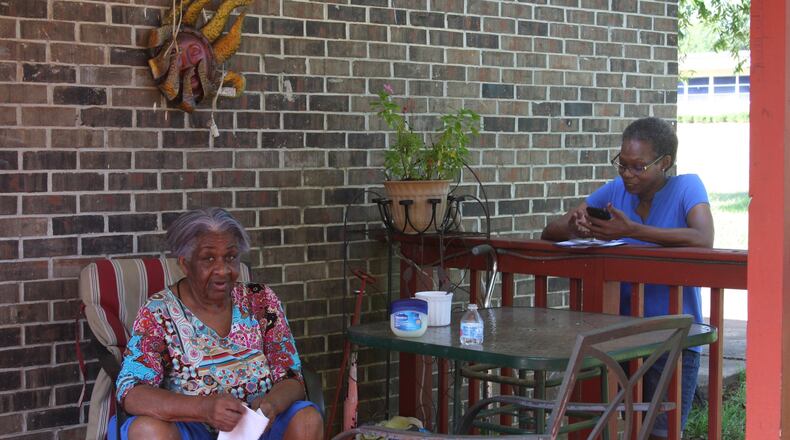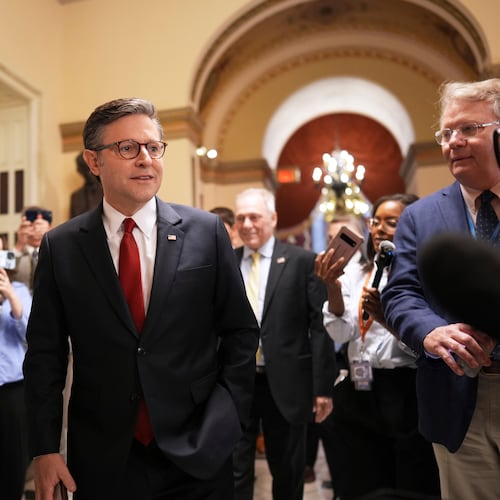Carolyn Baker wheels her Toyota through the quiet streets of Cuthbert looking for Democratic voters.
Although the county has changed all the address numbers, Baker refuses to use her GPS. She grew up on these streets.
“This is the first year I have canvassed. With Stacey Abrams and other female candidates, it is important to do this,” Baker says. “If she can be elected governor, that would be amazing. I am going to do everything I can to help her win.”
But the people she is looking for — 39 registered voters who usually vote in presidential elections but tend to miss midterms — are not easy to find this Saturday morning.
Nearly every door she knocks on offers no occupant. Everyone, Baker concludes, gets up early to go shopping in Albany or Eufaula, Ala.
“I can tell they’re not at home because they usually sit on their porch,” Baker says, leaving another house without having a chance to pitch how Abrams, the former state House minority leader, needs to be Georgia’s next governor.
Walking back to the Toyota, she is stopped in her tracks by Mildred Thornton, who is sitting comfortably on her side porch enjoying the early morning chill.
“You looking for me?” Thornton calls.
For Abrams, the answer is yes.
Thornton, Baker and thousands of other rural black voters may be the key to Abrams becoming Georgia’s first African-American and first female governor.
Abrams, a Democrat, is in a tight and pitched battle with Secretary of State Brian Kemp, a Republican with the backing of President Donald Trump, to succeed Gov. Nathan Deal.
She is hoping to catch a blue wave that is going to take her through the state’s black belt.
“I am the only candidate who speaks their language and has real comprehensive plans,” Abrams told The Atlanta Journal-Constitution. “There is an enthusiasm and hunger for a candidate who understands their community and wants to help lift them up. So I have been able to build deep relationships that will translate to voter engagement and voter participation.”
Rural vote could decide tight race
On Thornton’s porch, she and Baker play the name game, digging through their family roots and checking who each other knows in the small town. Thornton, 79, admits to Baker that she isn’t sure that she is registered to vote in the November election.
Baker checks. She is. But Thornton has no idea who Abrams is. So Baker explains.
“Oh. That is wonderful,” Thornton says. “I will vote for her, as long as she knows her stuff.”
Baker then hands her a flyer.
“Oh,” Thornton says, noticing for the first time that Abrams is black. “And she’s pretty.”
Baker smiles and moves on to her next house.
“I’ll be sitting right here next time you come,” Thornton shouts.
Baker said the encounter — she is usually trying to persuade older voters — is typical.
“A lot of people are not looking at the news. Older people don’t have computers. They don’t know who Stacey is,” said Baker, who is retired. “To be honest, I don’t know a lot about Stacey either. But the fact that she is a black female running for governor as a Democrat means she got my vote.”
Rural voters — particularly African-American ones — could play a key role in who is elected in November as only 8 percent of the respondents were undecided in a recent Atlanta Journal-Constitution/Channel 2 Action News poll. That same polls showed that Kemp and Abrams are deadlocked at 45 percent.
“Stacey is going to get 95 percent or more of the black vote, but it takes more,” said Archie Jackson, who lives in tiny Lenox, a Republican hotbed about 40 miles from the Florida line. “Especially in Georgia.”
Georgia’s Democratic machine and Abrams’ camp have dispatched waves of organizers through rural counties to knock on doors and make her case to a group of voters who they say have either been ignored or taken advantage of.
“I hope it is going to mean a lot. The black rural vote will be for Stacey Abrams,” said Fred van Hartesveldt, a retired historian at Fort Valley State University and one of the few active and vocal white Democrats in Fort Valley. “If African-Americans go to the polls, we will win. If they don’t go to the polls, we will not win.”
In the 2016 presidential election, 28 percent of people who cast ballots were black, while blacks represent 30 percent of registered voters in Georgia. But fewer longtime registered voters turned out as 69 percent of black voters in 2016 also voted in 2012, about a 1-point drop from those voting in 2012 who had also voted in 2008.
Abrams launched her campaign in Albany and has subsequently hit each of the state’s 159 counties.
‘Candidates don’t come south of I-285’
In Peach County, Kattie Kendrick just started an organization to increase black voter participation by at least 10 percent.
“One of the things I do like about Stacey Abrams is she is talking about rural Georgia,” said Kendrick, a former party boss in Peach County. “Candidates don’t come south of I-285, and when they come, they don’t understand what they see. Leader Abrams understands.”
Abrams, who supports a wide range of progressive policies, is running on a platform that appeals to rural voters such as expanding health care and fully funding public schools.
Meanwhile, Kemp’s strategy hinges on running up the score in rural areas that have been reliably Republican over the past decade, hoping that conservative policies and a pledge for more broadband will appeal to voters.
Kemp opposes the expansion of Medicaid and supports school choice, a path dictated by Trump, who carried Georgia in 2016 despite losing much of metro Atlanta precisely because he won by overwhelming margins in rural Georgia.
A new study by Georgetown University's Center for Children and Families and the University of North Carolina's Rural Health Project suggests that the potential impact from Medicaid expansion would be bigger in rural Georgia than in urban areas of the state.
Georgia, along with Alabama, Florida, Mississippi, Missouri, Oklahoma, South Dakota and Texas are among the non-expansion states with the highest rates of uninsured low-income adults in small towns and rural areas.
“I talk consistently about Medicaid, education and jobs. We know that this is a triumvirate in states that are successful,” Abrams said. “(Rural voters) want concrete solutions because they have been waiting for decades for someone to see them and offer them real help.”
‘People who felt taken for granted’
Rebecca DeHart, the executive director for the Democratic Party of Georgia, said the party has been building on a strategy to get rural voters since 2016.
“This is the first time the state party has made a concerted effort to reach outside of metro Atlanta in a new way,” DeHart said.
She said for the recent primary the party focused on 40 rural counties — all of which have fewer than 25,000 registered voters — and flooded the zone.
“We looked at the numbers and saw the drop-off and where votes had been left on the table. Anytime a Democrat doesn’t vote is a vote left on the table,” she said. “We looked at where we hadn’t been talking to voters. We talked to people who felt taken for granted because folks haven’t gone out and knocked on their doors.”
The party hired three full-time organizers to urge rural Georgians to vote, set up a robust hotline to combat voter suppression, and worked with stalwarts of black communities to “build relationships that we hadn’t before.”
The party also kept a close watch on Alabama and the surprise U.S. Senate run of Doug Jones, who beat Trump-backed Republican Roy Moore in a race that captured the nation’s attention.
“Doug Jones campaigned in all of the areas, and all of the areas turned out for him,” DeHart said. “Nationally, everybody thought Roy Moore was a creep, but the reason people turned out was not against Roy Moore, but for Doug Jones. Nobody ever came to their towns and said I want to expand Medicaid. They’d just never been asked until Doug asked.”
‘What made me get involved’
If there is a ground zero for Abrams’ rural efforts, it might be Cuthbert, the seat of Randolph County. Roughly 60 percent of the county’s 7,000 residents are black and one-third of them live below the poverty line, which is twice the state average.
This summer, Randolph County was in the middle of a national maelstrom as county officials attempted to close seven of nine polling places in the predominantly African-American area in southwest Georgia, claiming that they did not meet the standards of the federal Americans With Disabilities Act.
At one precinct, 95 percent of the voters were black. At another, a voter would have to make at least a 20-mile round-trip drive to cast a ballot.
Both Kemp and Abrams rejected the plan, which was eventually dropped.
But the ripple effects might have been massive.
“That is what made me get involved, too,” Baker said as she searched for her next address. “How can you do that?”
Located about 160 miles southwest of Atlanta, Randolph County was one of the few Southern rural counties to support Hillary Clinton, giving her 55 percent of its votes in 2016. Respectively, Jason Carter and Michelle Nunn both carried Randolph in the 2014 races for governor and the U.S. Senate.
“Randolph County can make a difference. We won’t put anybody in office, but it can put them over the hump,” said Bobby Jenkins, the chairman of the Randolph County Democratic Committee. “Stacey Abrams has made a concerted effort to visit small towns and not overlook the rural areas. She is just an energetic person, which is why everybody else is energetic.”
Support for Abrams, backlash against Trump
Ben Hill County is a straight shot 100 miles east of Randolph County. Joseph Manley, the chairman of the county’s Democratic committee, is still smiling over a visit by Abrams.
“It was a ground-moving experience, to have her come to our county. If only for a matter of minutes,” Manley said. “The venue was shoulder-to-shoulder, but she was able to push her way into the crowd. Even after she left, it took some time for people to disperse because we were on such a high.”
Manley said enthusiasm is a combination of support for Abrams and a backlash against Trump.
“Statewide, blacks feel this is an opportunity to have representation like we have never had before,” Manley said. “Federally, the nation has been polarized and racism has been re-energized. There is motivation from Donald Trump and encouragement from Stacey Abrams.”
That is where voters like Erma Wilburn come in.
Wilburn, 69, said she doesn’t get out to canvass for votes much since she recently fractured her spine.
So she knocks on doors only twice a week.
“I think we need to do what we can to get the vote out for the Democratic Party. Everybody realizes we’re in a dire situation,” said Wilburn, who lives on a farm in Worth County, where 75 percent of voters backed Trump in 2016. “In this area, a lot of people don’t go to polls or have issues where their polling places are. Certain populations will get discouraged. I have to keep them encouraged. There are lots of votes to be had here. We’ve just got to flush them out.”
COVERING BOTH SIDES
The Atlanta Journal-Constitution is covering all angles in a busy election year. We’ll have additional investigative coverage about both candidates for governor in the weeks leading up to the Nov. 6 election.
About the Author
Keep Reading
The Latest
Featured




